America’s Massive Decline in Gun Violence
Mass shootings rightly grab our attention. But the obscure the overall picture of violent crime.
This week’s mass shooting in San Bernandino, which killed 14 innocents and wounded another 21, seems sadly routine. We’ve had so many of these incidents in recent years that they flow together. And yet, as Max Ehrenfreund notes at the Washington Post, we’ve actually had a “massive decline” in gun violence over the last two decades.
Premeditated mass shootings in public places are happening more often, some researchers say, plunging towns and cities into grief and riveting the attention of a horrified nation. In general, though, fewer Americans are dying as a result of gun violence — a shift that began about two decades ago.
In 1993, there were seven homicides by firearm for every 100,000 Americans, according to a Pew Research Center analysis of data from the Centers for Disease Control and Prevention. By 2013, that figure had fallen by nearly half, to 3.6 — a total of 11,208 firearm homicides. The number of victims of crimes involving guns that did not result in death (such as robberies) declined even more precipitously, from 725 per 100,000 people in 1993 to 175 in 2013.
Older data suggests that gun violence might have been even more widespread previously. The rate of murder and manslaughter excluding negligence reached an apex in 1980, according to the FBI. That year, there were 10.8 willful killings per 100,000 people. Although not a perfect measure of the overall rate of gun violence, the decline in the rate of murder and manslaughter is suggestive: Two in three homicides these days are committed with guns.
This decline in gun violence is part of an overall decline in violent crime. According to the FBI’s data, the national rate of violent crime has decreased 49 percent since its apex in 1991. Even as a certain type of mass shooting is apparently becoming more frequent, America has become a much less violent place.
Ehrenfreund suggests several explanations for the decline including more cops on the beat, the use of computer data analysis to more effectively target policing, a sharp decline in alcohol consumption, the campaign to remove harmful lead from the environment, and an improved economy. There have also been demographic changes; an older population is less violent.
Regardless, the difference between perception and reality here is stark. Mass shootings of strangers are, quite naturally, scarier and more attention-grabbing than ordinary homicides involving people known to the shooter. They make national news and spark debates over the state of our society and what public policy solutions ought be applied. And, yet, they are a statistically insignificant part of the overall homicide numbers.
The Mother Jones article Ehrenfreund links, published in October 2014, notes that the rate of these mass shootings (defined as “attacks that took place in public, in which the shooter and the victims generally were unrelated and unknown to each other, and in which the shooter murdered four or more people”) has taken a sharp uptick since 2011. But the real news, from a dispassionate point of view, is how rare they are. The researchers note that “a public mass shooting occurred on average every 172 days since 1982” but that “every 64 days on average” starting with an incident on September 6, 2011. They estimate the likelihood of this spike occurring by chance at less than one percent. That is, of course, way too many. But it’s a tiny percentage of the overall homicide rate, whether measured in terms of incidents or deaths.
The spectacular nature of the mass shootings makes them natural fodder for public debate. But their rarity and the fact that they’re overwhelmingly committed by the mentally ill make them a poor choice for basing our public policy.
While I own multiple guns, I have no problem with background checks, registration, safety training, closing gun show loopholes, and various other measures offered in the wake of these incidents. They strike me as common sense for a variety of reasons. In combination, they’d make it slightly more difficult for petty criminals to get guns, make it slightly easier for police to investigate shootings after the fact, and help reduce accidental shootings. But they would have essentially no impact on mass shootings, which are rare and unique events.
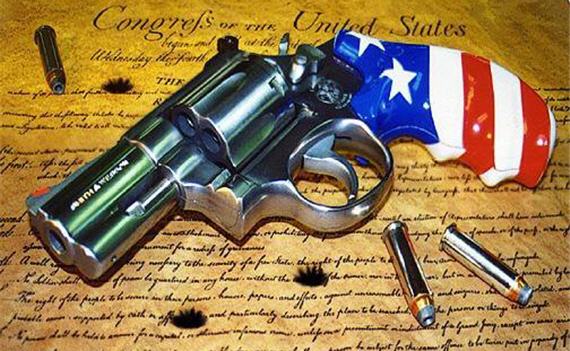

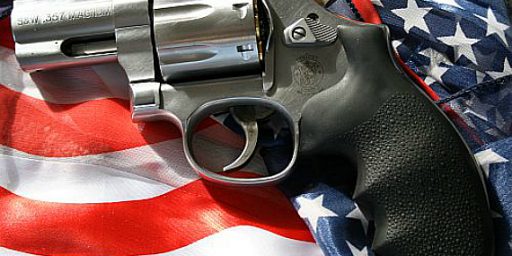
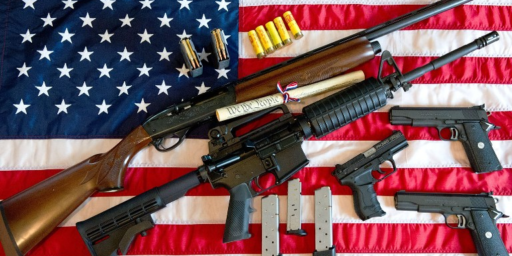
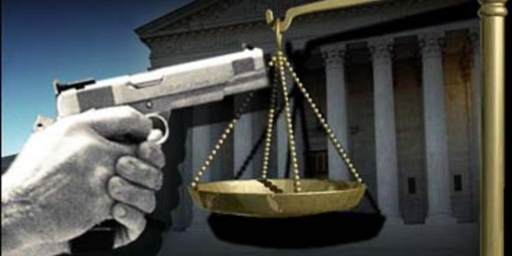
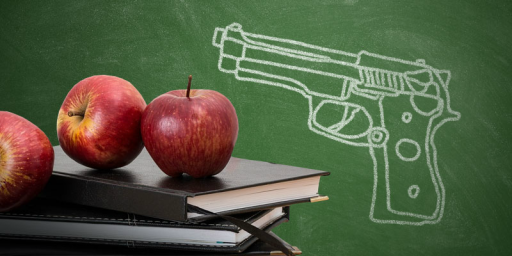
So we’ve gone from “utterly horrendous and unacceptable” to merely “horrendous and unacceptable.”
Hooray, I guess?
Massive adoption of concealed carry laws by the states?
leaving out suicides more than a bit disingenuous (United States is #3 in world in firearm suicides). But even without it, our firearm death rate is 7x Canada – the closest g8 country.
Also for 18-24 year olds (our students) homicide is the third leading cause of death after car accidents and suicide (mostly with guns).
but even then your article is in absolute not relative terms. In relative terms, 3.6 means we are a 3rd world central american/south american country with a drug gang problem.
At 3.6 we are slightly worse than Uruguay. and better than Costa Rica. Is that really what you aspire to? Is that really worth trumpeting? “one and a half times better than Nicaragua!” Your article leaves that out. I ask you, as an academic, if our health care, education, infrastructure, or military was “slightly better than costa rica but worse than Uruguay” would you write a blog post in support of it? Or would you say “we have to fix this.”
(and remember suicides – add that – and we are worse than Paraguay and slightly better than near war zone mexico. Used to be we aspired to “We’re Number 1!” Not “We’re 13th Worst!”)
https://en.wikipedia.org/wiki/List_of_countries_by_firearm-related_death_rate
here’s another way to look at relativity:
In the United States you are as likely to be killed by a gun as killed in your car. And we have seat belts, early warning systems, don’t let teens drive at night, registration, inspection, insurance for a car, no drinking and driving, and a host of other laws to try to limit car deaths (should be noted, also down “massively” since 1975). we do a hell of a lot more to protect ourselves and each other from cars than guns in most states.
http://www.nytimes.com/2015/12/05/upshot/in-other-countries-youre-as-likely-to-be-killed-by-a-falling-object-as-a-gun.html
I take the general point, but I have to agree with vantonni that even with the improvement our comparative rates of gun deaths are a huge indicator of a problem.
Beyond that, though, there is something profoundly wrong with the frequency we have of mass shootings.
@Steven L. Taylor: Usually the argument is that the NRA is blocking even baby steps because they claim it’s not working. Now someone shows baby steps are working, and suddenly the left doesn’t like it because it’s not working enough. Ingenious, heads I win, tails you lose.
Here in the Portland, Oregon area we are seeing an increase in gang violence with non gang members often collateral damage. Even here in the progressive peoples republic the blacks are still largely segregated in one part of the city. This problem is exacerbated by gentrification of that area by more affluent young whites and rent and property taxes increase forcing many blacks out of their homes.
In the suburbs we see turf wars between Hispanic and Oriental gangs, once again a lot of collateral damage. The Hispanic gangs are largely made up of 4th or 5th generation people most of whom don’t even speak Spanish anymore. The Oriental gangs are largely Vietnamese and Cambodians. remnants of the wars in SE Asia in the 60s and early 70s.
These gang members frequently obtain their weapons illegally although the gun show exception is also a factor.
@David Owen:
When were concealed carry laws changed? How has the rate of concealed carry changed? The chart in the linked WAPO article show virtually all of the decline occurring between 1993 and 2000. Little or no change since. The reduction in gun crime and the open carry wave overlap. But the number of concealed carry permits continues to increase rapidly, while the gun crime rate is pretty steady since 2000. I suspect there is not a good correlation.
Ehrenfreund offers five possible explanations, as noted by James. Personally, I like the lead hypothesis a lot.
Everything is beautiful
In it’s own way…
Singing in the rain, eh James?
More seriously, there are a lot of things we can do, not least of which is regulate them just like we do abortions.
(sorry, no linkage as that seems to throw me into the spam filter)
Then maybe you should support the party that is in favor of those “common sense” measures rather than support the party that thinks you are a raving Marxist lunatic and “gun grabber” for even bringing those measures up for discussion. Just saying.
As to the uptick in mass shootings, it seems to have followed directly upon the Heller decision(2008), the Republican takeover of Congress and many state legislatures in 2010, and the subsequent passage of many “open carry” and “shall issue” concealed carry laws, which made it even easier to buy and carry around guns. Why, it’s almost as if loosening up the gun laws made it easier for mentally unstable people to get guns! Go figure, right?
I dunno. These rare events aren’t so rare anymore. There have been 355 mass shootings this year, according to the Mass Shootings Tracker.
Meanwhile, go across the border to Canada, and the rate drops to almost none. Since I don’t believe there is anything magical about the Canadian border that makes the people living north of it less violent, I’m going to put it down to better gun laws. Here is nutshell version of the Canadian law:
I think the key to the Canadian laws is the requirement that the purchaser of a gun has to undergo safety training.I think that having to undergo that course effectively screens out the mentally unstable. Someone like Lanza,Holmes or Dear (Sandy Hook, Aurora, Colorado Springs) would have difficulty passing such a course, which includes a section on the “Responsibilities of the Firearms Owner.”
Would such screening have caught a radicalized Farouk, who presented as normal? Maybe not. But the interposition of a human screener (maybe trained to spot evidence of mental instability) and a requirement that you have to pass a course that instructs on being a responsible fire owner would help a lot to reduce mass shootings,IMO, and Canada is evidence for this. (Also too, Switzerland, which actually has a “well regulated militia.”
The interesting thing is that the NRA folks are peddling this data to neutral observers, even as they use talk about the coming social collapse and roving gangs of “rapers” to scare up their membership. ..
But, to be honest, liberals are doing something similar: we view decline in violent crime as good reason to start reforming policing, yet are convinced guns are tearing society apart..
@Mu:
And which baby steps would those be?
@vantonni:
Indeed. Maybe it’s a good time to repost Neil. D. Tyson’s series of tweets on gun violence:
Boy, howdy, did the gun nuts go crazy about that little Tweet storm. It was worse since they couldn’t actually refute the figures. It also exposes the hypocrisy of the conservative hypocrisy on guns. Of you are going to apesh!t about terrorism, should n’t you be busy passing legislation to deal with the far more destruction problem of gun violence, instead of only offering “thoughts and prayers” ( Prrayer is good:
@vantonni:
Indeed. Maybe it’s a good time to repost Neil. D. Tyson’s series of tweets on gun violence:
Boy, howdy, did the gun nuts go crazy about that little Tweet storm. It was worse since they couldn’t actually refute the figures. It also exposes conservative hypocrisy on guns. If you are going to go crazy about terrorism, shouldn’t you be busy passing legislation to deal with the far more destructive problem of gun violence, instead of only offering “thoughts and prayers?” ( Prayer is good: nothing but prayer is hypocrisy-See James 2:14-26, Isa. 1:15-17, and many other Biblical passages).
Yes, but … one of the problems is that people focus on death by firearms. Mainly because it supports their point. If you look at total suicide rate, the US is not very high. And with total murder rate, the difference between us and other countries is much lower. This is one of the things that’s annoying me in the current debate — the focus on death exclusively by firearms elides massive amounts of the problem. When you look at total murders, suicides or violent deaths, the supposed correlations between gun ownership and violence disappear. Guns are the method, not the message.
I think the problem is not guns. It is a culture that, from far too much of the political spectrum, embraces violence and devalues life. How are we supposed to decrease violence when the cops gun a man down in the street and the politicians stumble over each other to proclaim it justified? How can we tell people not to kill when we don’t even know how many countries we’re at war with or how many innocent people we’ve droned to death this week or whether the lethal injection cocktail actually works?
That’s another muddy point. Firearms deaths have plunged … without gun control. It’s just that automobile accidents have plunged faster. And mainly because the changes need to make cars safer (mostly cracking down on drunk driving and making people wear seatbelts) are obvious, non-controversial and comparatively easy to enforce. You can’t conceal a car in your jacket.
Be careful with that, though. Previously, we’ve defined mass shootings as having three/four or more fatalities. That tracker defines a mass shooting as four or more victims, regardless of deaths. It therefore tracks more incidents and includes gang violence. And there is zero information about whether that has declined as sharply as other violence because it’s only been tracked for two years. The broader you define the sample, the more likely you are to lock into the overall decline in violence. Twenty years ago, that same definition might have given a thousand “mass shootings” a year.
(The Mother Jones study has a similar flaw. It posits a rise in mass shootings. But it is based on internet news searches and therefore is massively incomplete in the 1980’s and 1990’s. If you look at the data, as I did, you basically see a spike of a mass shootings in 2012. These things tend to be spiky, which suggests that copycats are a big factor.)
What you have failed to do is to notice the considerable increase in violence-related non-fatal gun injuries.
Per the CDC, non-fatal violence-related gun injuries increased 49% between 2001 and 2013. The rate per population increased by 34%.
Combine that with the number of fatal firearms-related homicides, and there was a 40% increase in the number of incidents and a 26% increase in the rate.
Those numbers should tell you that better medical and trauma care is allowing gunshot victims to survive and/or more of them were somehow lucky enough not to die. That doesn’t mean that getting shot is not a problem or that guns don’t play a substantial role in US homicides or attempted homicides.
And then there’s the Donohue and Levitt theory that legalized abortion has contributed to the decreased crime rate: “Legalized abortion appears to account for as much as 50 percent of the recent drop in crime.”
See http://pricetheory.uchicago.edu/levitt/Papers/DonohueLevittTheImpactOfLegalized2001.pdf
Where are you getting that data? Pew shows the exact opposite.
The CDC calculates gun injuries
The FBI reports homicide statistics.
http://webappa.cdc.gov/sasweb/ncipc/nfirates2001.html
https://www.fbi.gov/stats-services/crimestats
So the country is less deadly and less violent than ever before. There is less crime than ever before. And yet … the public is being told every day how horrible everything is and that they need to protect themselves. I work with people who talk about guns all the time and how they need them for protection. All this tells me is that pro-gun propaganda and marketing works.
@Hal_10000:
Honestly? Nonsense. There is no significant difference in culture between the US and Canada, and only a slightly greater difference between the US and the UK or Australia. But there is a vast difference in the firearms death rate. The reason? I’ll take difference in gun safety laws for $2,000, Alex. Now, gun rights enthusiasts pretty much hate the numbers on this. So they obfuscate, lie , and reach for pretty much any none gun related explanation. Their method really amounts to “Ignore data, believe my warm , fuzzy stories about hard to pin down factors like history, culture,video games, mental illness , etc.”
But they have video games and mental illness and alcohol and histories of violence in all those other countries too. The difference?They have targeted, effective serious gun safety legislation. That is all.
To hell with the decline in violent crime as a reason…it is a good idea to reform policing because some cops seem to think of young black males as nothing more than target practice and so many police departments are becoming far too militarized…
Violence-Related Firearm Gunshot Nonfatal Injuries and Rates per 100,000
2001 – 45,316 – 15.90
2002 – 41,262 – 14.35
2003 – 46,894 – 16.16
2004 – 47,834 – 16.34
2005 – 54,437 – 18.42
2006 – 56,739 – 19.02
2007 – 54,165 – 17.98
2008 – 61,406 – 20.19
2009 – 48,158 – 15.70
2010 – 59,344 – 19.22
2011 – 59,208 – 19.00
2012 – 64,034 – 20.40
2013 – 67,394 – 21.32
Homicides with firearms:
2001 – 8,890
2002 – 9,528
2003 – 9,659
2004 – 9,326
2005 – 10,100
2006 – 10,177
2007 – 10,086
2008 – 9,484
2009 – 9,146
2010 – 8,775
2011 – 8,583
2012 – 8,855
2013 – 8,454
Add them together:
2001 – 54,206
2002 – 50,790
2003 – 56,553
2004 – 57,160
2005 – 64,537
2006 – 66,916
2007 – 64,251
2008 – 70,890
2009 – 57,304
2010 – 68,119
2011 – 67,791
2012 – 72,889
2013 – 75,848
Actually, the impact on criminal access to firearms would be negligible compared to today. Of those incarcerated for crimes in which they possessed a firearm, most got their firearm from “off the street”/drug dealers. This number rises for those under 21. The next most frequent source is to buy, borrow, rent from friends or family. Only ~14% purchased their firearm from a commercial dealer. But less than 2% purchased their firearm at, and this is a combined total, either a flea market or gun show. And in the report, which has surprisingly not been updated in 10 years, doesn’t delve into whether the incarcerated individual could lawfully purchase/possess a firearm at the time of the purchase/transfer.
But let’s go with gun safety training. Not a bad idea, but it is a cost being imposed on the exercise of an enumerated Constitutional right. So the way to avoid Constitutional issues is for government to fund the courses and make them readily available. Most of the course could be online and could be taught in the K-12 curriculum. The NRA has a good and long running gun safety training program. Perhaps they should be given government grants to provide gun safety training in schools and community centers to all individuals? Not unlike how the government gives grants to many Lefty organizations to provide some social service, such as job skill training.
@Steven L. Taylor:
Oh, of course. My point, and I presume Ehrenfreund’s, is merely that there’s a disconnect between public perception and the aggregate statistics. We’re an incredibly violent society and easy access to guns serves as a force multiplier. But homicide by guns, like all violent crime, is down massively in recent years even while these spree shootings are on the rise. I suspect the latter is at least partly a function of the desire for fame and a media environment where these things go viral.
@James Joyner:
Based upon the data that I have provided, that is absolutely not true if you define “recent” as 2001+.
Using that logic, all these new Republican ID state laws regarding voting should be struck down as they impose a cost on the exercise of an enumerated Constitutional right…
@Pch101:
Yeah, I’d be weary of using the CDC’s data there. It’s based on extrapolating the CPSC’s data, which is flaky and not comparable year-to-year (they specifically warn about this on the web site). Pew’s data is based on the NCVS, which is more complete.
You can see that by comparing the rates, which are ten times higher in the NCVS sample because they are complete and systematic.
@Hal_10000:
True. And if someone proposed re-instituting a Motion Picture Production Code like regime on violence in movies, TV, and video games I would support it. Seeing a big shootout in every other movie, in which the good guy with a gun almost always wins, cannot be good for impressionable youth. However, as I understand it the Code wasn’t repealed so much as it fell apart once the courts ruled movies were subject to the 1st Amendment. So I don’t see how to make something like it work.
While I agree that a good deal less war would help, I don’t really see it as within the power of the government to change our culture. Nor am I sure I want to live under a government that would try. Would that not fall under “big government”? That said, I agree with Reynolds that culture is slowly changing away from our gun culture. I think largely as a result of urbanization. However, gay rights shows that culture can reach a tipping point and change very quickly, so I may be overly pessimistic.
Which brings us to guns. It’s a question of what’s actionable. Actionable not in the legal sense, but in the project management usage. Can a goal be broken down into executable action items? Culture change, not really. But there are feasible, albeit politically difficult, steps that would reduce, if not eliminate, gun casualties.
Are such action items feasible within the 2nd Amendment? Yes. But it requires reverting to the traditional interpretation. This likely requires replacing John Roberts or others. This can’t be down quickly, but will happen one way or another.
Should we do something to limit guns? Again – project management: cost/benefit analysis. Contemplate that something like a quarter million people get shot every year in this country. Contemplate that a toddler shoots someone about once a week (yes, shoots someone, often themselves). What do you think?
@Hal_10000:
Er, the NCVS uses this very same data to measure this. Note figure 11: http://www.bjs.gov/content/pub/pdf/fv9311.pdf So no, you’re wrong.
You are confusing “non-fatal firearm victimizations” with “Violence-Related Firearm Gunshot Nonfatal Injuries”. The former measures those who are threatened with guns in a variety of ways, the latter measures those who were actually shot.
The overall rate of gun victimization is declining, but the number and rate of those who are shot are increasing. The two facts are not contradictory.
@James Joyner:
What I don’t get is the insistence by the right that gun rights are over-regulated, that a national database of guns will lead to black helicopters, that the CDC should not be allowed study gun ownership, that loopholes and straw purchases are a measure of “freedom.”
America is a big accessible market for terrorism, gang violence, organized crime, and the mentally ill. Why does the right want to subsidize that? Is this simply the price we pay so people can collect guns and shoot them on the range? Go hunting? Why should random people have to die to make your hobby more convenient?
No one is calling for a ban on guns. Everyone knows that horse has left the barn. But a national database, eliminating loopholes, eliminating some guns on the market, and more scrutiny and liability for gun owners and buyers and sellers is not beyond the pale.
But why the total resistance? Why does everyone ignore the “well-regulated” clause in the 2nd amendment?
I honestly, truly, do not and cannot understand the Right’s resistance on this issue.
@gVOR08:
The government has quite deliberately changed the culture several times:
– smoking is way, way down
– drunk driving is way, way down
– slavery is almost gone
– the integration of the army preceded the civil rights movement
– elder poverty reduced by Social Security
I’m pretty ok with each of those.
@Lit3Bolt:
It’s essentially a slippery slope argument.
This is also what negotiator Herb Cohen referred to as “Soviet-style negotiation.” The idea is to take an extreme, aggressive position in an effort to move the middle closer to their side of the negotiation table.
This approach has the added benefit of gaining the squeaky wheel advantage: The pro-gun diehards are relatively few in number, but they are more vocal, motivated and strident than the anti-gun contingent.
Guns have taken a cultural value, as they are synonymous with fear of crime (read: fear of minorities.) It’s the new Jim Crow, one that resonates among certain demographics.
@Pch101:
So gun rights are white rights is essentially true?
@Lit3Bolt:
Because the convenience of gun owners and their freedom to buy and carry guns around anyplace, anytime trumps every other right, interest, and value , even at the cost of thousands of unnecessary gun deaths per year.
And Liberty, Freedom, something, something.
And John Wayne, Clint Eastwood, and my penis isn’t big enough.
Think that sums it up.
@Lit3Bolt:
If blacks started joining the NRA in droves and started insisting on their right to carry AR15s into malls and onto playgrounds, you would see reasonable gun safety legislation passed overnight.
@Lit3Bolt:
You may have noticed that those who can’t shut up about black-on-black crime never bother to mention male-on-male crime, which is even more statistically significant.
As I noted elsewhere, a bigot is one who notes individual distinctions in his own group while stereotyping those who don’t belong to his group. The numbers tell us that men are dangerous, yet good luck getting a white male gun advocate to form an argument on that basis.
@Lit3Bolt:
This may help you understand:
http://www.vox.com/2015/12/4/9845146/mass-shootings-gun-control
Pay special attention to the section headed “Guns have become a last-ditch effort to impose control on a world slipping away.”
@Gustopher: So what are you proposing the Federal government should do to change our gun culture significantly without doing things that would fall under “gun control”. Or are you counting gun control legislation as cultural change? I took Hal_1000 to be saying change culture instead of dealing with guns directly.
This week’s terrorist shooting attack in San Bernandino
FTFY
So isn’t there a big opportunity for Democrats here?
An pair of ISIS terrorists just bought a massive pile of guns legally in this country. Will the Democrats start to demagogue the Right from the right?
“Republicans and the NRA. Soft on crime. Soft on terrorism.
Republicans and the NRA believes the 2nd Amendment gives anyone in America has a right to an automatic weapon…including radical Muslims and inner city ganglords.
Republicans and the NRA want your children to be unsafe by promoting open gun carry laws in parks, playgrounds and restaurants.
Republicans and the NRA. Teachers of terrorism. Coddlers of criminals. They believe everyone needs a gun…including ISIS.”
The ad basically writes itself.
@stonetools: Before I went to Korea, I had a Japanese exchange student in one of my research classes. He chose as his topic the notion (popular at the time, but out of favor at the moment) that violent video games promote or provoke or condition children to act out violently. In a meeting with him, the following conversation occurred.
Me: Do Japanese children play as many shooting games as American children do?
Student: Yes, I suppose that they do.
Me: Are Japanese children as inclined to violence as American children?
Student: No, clearly they are not?
Me: If Japanese and American children play these games at equal rates, how is it that the games cause Americans to be prone to violence while Japanese are not?
Student: Japanese people are morally superior to Americans and so are better able to resist the inclination to violence, so Japanese children have the same advantage.
Hmmmm… He may have been on to something.
@Lit3Bolt: Many who are sympathetic with the NRA may over-react to sensible regulation, but I think that such is understandable when people like Piers Morgan compare US crime rates to those of places like England/Wales, Australia, etc.
If you “nobody wants to take away Americans’ guns” then why compare the US crime rate to counties that did take away guns from citizens?
@stonetools:
Not nonsense at all. Look at the stats of men killing themselves vs females. Notice anything? Men shootings vs women.
Go see the !movie the mask you live in.